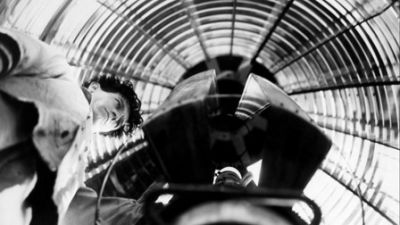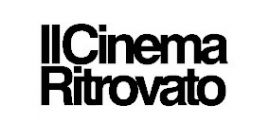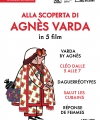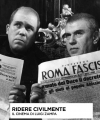
GARDIENS DE PHARE
(Francia/1929) R.: Jean Grémillon. D.: 72'. Did. francesi
Gardiens de phare è in origine la versione filmica di una pièce di successo di Autier e Cloquemin, appartenente al repertorio del Grand Guignol. Albert Décamps ricorda in apertura della sua rimarchevole analisi la professione di fede di Jacques Feyder che ne scriverà la sceneggiatura e l'adattamento: "Lo schermo che reclama delle immagini e non delle parole può esigere una rielaborazione totale del soggetto, può imporre all'adattatore la necessità di creare delle immagini che in apparenza sono molto lontane da quelle che, in una forma letteraria, si trovano nel libro o nella pièce... Il dinamismo straordinario del cinema, la sua estrema mobilità nel tempo e nello spazio autorizzano anche il cineasta a modificare l'ordine del movimento e dell'azione... Tutto gli è permesso dacché è in gioco la perfezione visiva della sua opera. Il cineasta che traduce visivamente un'opera letteraria non ha che uno scopo, fare del cinema, fare un film. Deve rifiutare ogni altra considerazione: il contrario è una confessione d'impotenza da parte sua". Nella fattispecie, si vede subito che il cinema ha potuto farci vedere quello che non è raccontato nella pièce, ma l'essenziale, per i nostri occhi, è che il dramma sia fortemente calato in un quadro marino. La sorte dei personaggi qui - come più tardi in Lumière d'été - sembra iscritta nel paesaggio. Dall'inizio il mare, le dune, il faro impongono una presenza magica che fa del luogo una sorta di trappola. Questi connotati visivi sono al centro del film e gli altri - in particolare la luce riflessa sulle lame di vetro della lanterna del faro - hanno senso estetico e drammatico proprio perché legati alla scenografia. Il mare, il faro definiscono spazialmente e moralmente una solitudine ed è l'espressione iniziale e costantemente rinnovata della solitudine che crea il tragico, come sottolinea Albert Décamps: "Ciò che ci sconvolge, che ci colpisce al più profondo di noi stessi, è innanzitutto la solitudine di due uomini, e la loro impotenza che deriva da questa solitudine. Quale che sia la definizione che si attribuisce alla situazione in cui si trovano, che si invochi il destino, la fatalità, un concorso di circostanze, una volontà malefica ostinata a perderli, il dramma che vivono nasce dal loro isolamento. Ciò che è tragico, non è che il figlio sia stato morso da un cane rabbioso, è che essendo stato morso, si trovi in condizioni tali da essere privato di qualsiasi soccorso. Non può comunicare con la terraferma, e anche se potesse, la tempesta impedirebbe che si possa soccorrerlo. È tragica la sua presa di coscienza del male che lo divora e gli sforzi impotenti che tenta per dominarsi".
(Henri Agel, Jean Grémillon, Lherminier, Paris 1984)
Originally, Gardiens de phare is the film version of a successful play by Autier and Cloquemin from the "Grand Guignol" repertoire. In the first pages of his remarkable analysis, Albert Décamps recounts the credo of Jacques Feyder, who would eventually write the film's screenplay and adaptation: "The screen requires images, not words, and therefore might demand a total revision of the character. This can force the screenwriter to create images that are apparently very distant from their literary form in the book or the play... The extraordinary dynamism of film, its extreme mobility through time and space, also allow the filmmaker to modify the order of movement and action... The filmmaker must exercise the freedom to move away from a literal interpretation, the visual perfection of his work is in play. The filmmaker who visually interprets a literary piece has only one goal: making cinema, making a film. He must refute any other consideration: otherwise he admits his own impotence". More specifically, it is immediately obvious that cinema can demonstrate what is not narrated in the play. In this case the essential visual aspect is that the drama is firmly anchored in a seaside setting. The fate of the characters in this film - as will be later in Lumière d'été - appears to be engraved in the landscape. From the very beginning the sea, the dunes, and the lighthouse command a magical presence that transforms the location into a confined space. These visual characteristics are central to the film while the others - particularly the light reflected on the blades of glass of the lantern in the lighthouse - acquire an esthetic and dramatic tone precisely because they are tied to the set design. The sea and the lighthouse define a solitude that is both spatial and moral and are the initial and constantly reiterated expression of a solitude that creates tragedy. As Albert Décamps remarks: "What shocks us, what strikes at the very core of our being, is first of all the solitude of two beings, and their total impotence deriving from this solitude. Whatever the cause cited for their situation, whether destiny, fate, a combination of circumstances, or an evil force plaguing them, the drama they are living stems from their isolation. What is truly tragic is not that the son was bitten by a rabid dog, but rather that having been bitten he finds himself in a situation without any possibility of being rescued. He cannot communicate with the mainland, and even if he could, the storm would prevent any rescue attempt. What is also tragic is his awareness of the illness eating away at him and his unsuccessful attempts to control himself.
(Henri Agel, Jean Grémillon, Lherminier, Paris 1984)
ESSAIS AU BORD DE LA MER
(Francia/1926) R.: Jean Grémillon. D.: 3'
CASTING ELLA MAILLART
(Francia/ca. 1926) R.: Jean Grémillon. D.: 2'
Introduce Mariann Lewinsky
Ella Maillart (Ginevra 1903-1997) visse una vita indipendente, viaggiando, scattando fotografie e scrivendo. Tra i suoi film in 16mm girati in Afghanistan (1939), India (1940 e 1957) e Nepal (1951) è stato ritrovato un rullo in formato 35mm, "Ella Maillart de Jean Grémillon", contenente immagini della giovane Ella e prove di ripresa realizzate nel 1926 sulla costa dell'Ile de Groix, in vista di La Croisière de L'Atalante di Grémillon. Maillart, che era una campionessa di vela, e la sua migliore amica Miette de Saussure (futura moglie di Henri Seyrig e madre di Delphine), skipper e proprietaria della barca L'Atalante, progettavano di attraversare l'Atlantico e di finanziare la spedizione facendola filmare da Grémillon. Restaurati e rimontati nel 2004, i pochi minuti di "Ella Maillart de Jean Grémillon" rievocano queste persone straordinarie e le loro vite.
Ella Maillart (Geneva 1903-1997) lived an independent life, travelling, taking photographs and writing. Among the 16mm films she made in Afghanistan (1939), India (1940 and 1957) and to Nepal (1951), a 35mm reel labelled "Ella Maillart de Jean Grémillon" was discovered. It contained a few shots of Ella in her youth, as well as unedited test shots taken in 1926 on the coast of Ile de Groix, in preparation for La Croisière de L'Atalante. Maillart, a champion sailor, and her best friend Miette de Saussure - who would become Mme Henri Seyrig and mother of Delphine and was skipper and owner of the clipper L'Atalante - planned to sail to the Pacific and finance the expedition by having it filmed, by Grémillon, and distributing the film. Restored and re-edited in 2004, the few minutes of "E.M. de J.G." are a link to amazing personalities and their lives.
CHARTRES
(Francia/1923) R.: Jean Grémillon. D.: 13'. Did. francesi
Prodotto nel 1923 dal SIDF (Service d'Information Documentaire par le Film), è il primo cortometraggio di Jean Grémillon che realizzò con l'apporto di Georges Perinal quale direttore della fotografia. Dieci minuti che esaltano la bellezza della cattedrale gotica del XIII secolo, della cittadina e del paesaggio circostante. Il film inizia mostrando il disegno perfetto della cattedrale che svetta nelle pianure della Beauce. Poi la macchina da presa ne percorre il corpo, varcando i portali e accarezzandone la facciata, le sculture che la adornano, le arcate, isolando la statua dell'angelo che si innalza sulla colonna, mentre il testo, con qualche abbandono lirico, commenta "Non si sa cosa ammirare di più... o le lunghe verticali che percorrono il cielo...", ossia i pilastri e le colonne che si ergono verso l'alto, "o l'angoscia universale che esprimono certe figure", alludendo ai bassorilievi dei santi dalle lunghe barbe, scolpiti nella facciata, con i volti emaciati dal travaglio spirituale, "o l'austera grandezza del simbolismo architettonico", la forma imponente ed elegante della cattedrale gotica che si impone nello spazio, "o il silenzio e la quiete che diffondono le vetrate". Poi la macchina da presa entra all'interno della cattedrale e si sofferma a contemplare il disegno delle vetrate e i giochi luministici fra interno ed esterno. In seguito il film si addentra nel piccolo mondo che circonda l'edificio e vediamo l'antico vescovado dei confessori delle regine di Francia, le vecchie case che si affacciano su strade e stradine. Quindi ci introduciamo all'interno di un antico edificio e non manca qualche breve quadretto di vita quotidiana - una donna che raccoglie acqua nel secchio da una fontana, le massaie che lavano i panni - per poi passare in rassegna i monumenti dedicati ai caduti della città e compiere un breve itinerario nei meandri della Chartres 'bassa', da cui traspare "la tranquillità serena delle vecchie città".
(Roberto Chiesi)
Chartres is the first short film by Jean Grémillon, shot with Georges Perinal's contribution as director of photography. Produced in 1923 by SIDF (Service d'Information Documentaire par le Film), it is a ten-minute review of the beauty of Chartres' thirteenth century gothic cathedral, the city itself, and the surrounding scenery. The film begins by revealing the perfectly formed cathedral that rises out of the Beauce valley. The camera then pans over the main body of the church, crossing the portals, caressing its façade and the sculptures that adorn it, focusing on the angel crowning the column, while the commentary, with some poetic license, states: "It's hard to decide what to admire more... the long vertical lines that travel across the sky..." that is, the pillars and the columns that reach skywards, "or the universal anguish transmitted by figurative representations", referring to the bas-reliefs of the bearded saints carved into the façade, their faces emaciated by spiritual suffering, "or the austere magnificence of the architectural symbolism", the imposing and elegant shape of the gothic cathedral with its commanding presence, "or the silence and the quiet that emanates from the stained glass windows". The camera then enters the cathedral and lingers on the design of the stained glass windows and the playful contrasts of outdoor and indoor lighting. Next, the film portrays the small world that surrounds the building, and we can see the old bishop's palace, once home to the confessors for the French queens, and old houses that overlook streets and alleys. The final camera take enters an old building with scenes of everyday life - a woman drawing water in a pail from a fountain, housewives washing clothes - the camera then moves to the memorials to the city's fallen heroes, and closes with a short stroll through the twists and turns of 'low' Chartres illustrating the "serene tranquility of old cities".
(Roberto Chiesi)
Accompagnamento al piano di Neil Brand

Tariffe:
Aria condizionata
Info: 051224605











